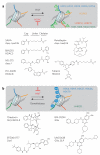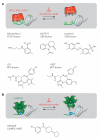Chromatin as an expansive canvas for chemical biology
- PMID: 22510649
- PMCID: PMC4005273
- DOI: 10.1038/nchembio.938
Chromatin as an expansive canvas for chemical biology
Abstract
Chromatin is extensively chemically modified and thereby acts as a dynamic signaling platform controlling gene function. Chromatin regulation is integral to cell differentiation, lineage commitment and organism development, whereas chromatin dysregulation can lead to age-related and neurodegenerative disorders as well as cancer. Investigating chromatin biology presents a unique challenge, as the issue spans many disciplines, including cell and systems biology, biochemistry and molecular biophysics. In recent years, the application of chemical biology methods for investigating chromatin processes has gained considerable traction. Indeed, chemical biologists now have at their disposal powerful chemical tools that allow chromatin biology to be scrutinized at the level of the cell all the way down to the single chromatin fiber. Here we present recent examples of how this rapidly expanding palette of chemical tools is being used to paint a detailed picture of chromatin function in organism development and disease.
Figures






References
-
- Jenuwein T, Allis CD. Translating the histone code. Science. 2001;293:1074–1080. - PubMed
Publication types
MeSH terms
Substances
Grants and funding
LinkOut - more resources
Full Text Sources
Other Literature Sources

